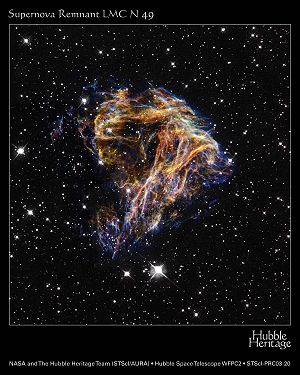- LHA 120-N 49
-
LHA 120-N 49
N49, vu par le télescope spatial HubbleDonnées d'observation
Époque J2000.0Ascension droite 05h 26m 01.00s Déclinaison -66° 05′ 06.0″ Coordonnées galactiques ℓ=276,0964, b=-33,2447 Constellation Dorade Galaxie hôte Grand Nuage de Magellan Découverte 1956 (découverte), 1973 (identification) Type de rémanent Coquille Taille angulaire (minute d'angle) 0,40 Densité de flux à 1 GHz (Jy) ? Indice spectral 0,49 Distance (kpc) 51 Méthode d'estimation de la distance Galaxie hôte Aspect en radio ? Aspect en X Coquille nettement plus régulière qu'en optique Aspect en optique Coquille assez irrégulière, avec structure filamentaire Autres désignations SNR B0525-66.1, LHA 120-N 49 Notes Situé sur la ligne de visée de SGR 0526-66 qu'il abrite peut-être. LHA 120-N 49, abrégé en N49, est un rémanent de supernova situé dans la galaxie du Grand Nuage de Magellan. Il est soupçonné abriter en son sein le sursauteur gamma mou SGR 0526-66, premier objet de ce type à avoir été découvert.
Sommaire
Découverte
N49 a été catalogué en 1956 par Karl G. Henize[1] comme étant une nébuleuse présentant une émission H-alpha. C'est en 1973 qu'il fut identifié comme étant un rémanent de supernova[2]. C'est suite à l'observation d'un bouffée de rayons gamma en 1979 que put être annoncé le fait que ce rémanent était l'hôte du sursauteur gamma mou SGR 0526-66, dont la position fut estimée par la mesure précise des temps d'arrivée de la bouffée de rayons gamma mesurée par plusieurs satellites artificiels munis de détecteurs de rayons gamma alors en service (en particulier Pioneer-Venus Observatory, International Sun-Earth Explorer 3, Helios B, ainsi que Venera 11, Venera 12 et Prognoz 7)[3],[4].
Caractéristiques physique
Ce rémanent est également détecté dans le domaine des ondes radio. Son indice spectral est de 0,49, typique d'un objet de ce type. Sa brillance de surface est élevée, à 96,3×10-19 W⋅m-2⋅Hz-1⋅sr-1, ce qui en fait le rémanent le plus brillant du Grand Nuage dans le domaine visible. La distance physique au Grand Nuage de Magellan étant connue, la taille angulaire du rémanent donne immédiatement sa taille physique, d'environ 6 parsecs, le rémanent étant de forme assez irrégulière (évoquant les contours de l'Amérique du Sud).
Voir aussi
Liens externes
- (en) LHA 120-N 49 sur la base de données Simbad du Centre de données astronomiques de Strasbourg
- N49 vu par le télescope spatial Hubble
- N49 vu par le télescope spatial Chandra
Notes
- (en) Karl G. Henize, Catalogues of H-alpha emission stars and nebulae in the Magellanic Clouds, Astrophysical Journal Supplement Series, 2, 315-344 (1956) Voir en ligne.
- (en) D. S. Mathewson & J. N. Clarke, Supernova remnants in the Large Magellanic Cloud, Astrophysical Journal, 170, 725-738 (1973) Voir en ligne.
- (en) T. L. Cline et al., Detection of a fast, intense and unusual gamma-ray transient, Astrophysical Journal Letters, 237, L1-L5 (1980) Voir en ligne
- (en) W. D. Evans et al., Location of the gamma-ray transient event of 1979 March 5, Astrophysical Journal Letters, 237, L7-L9 (1980) Voir en ligne.
Wikimedia Foundation. 2010.

